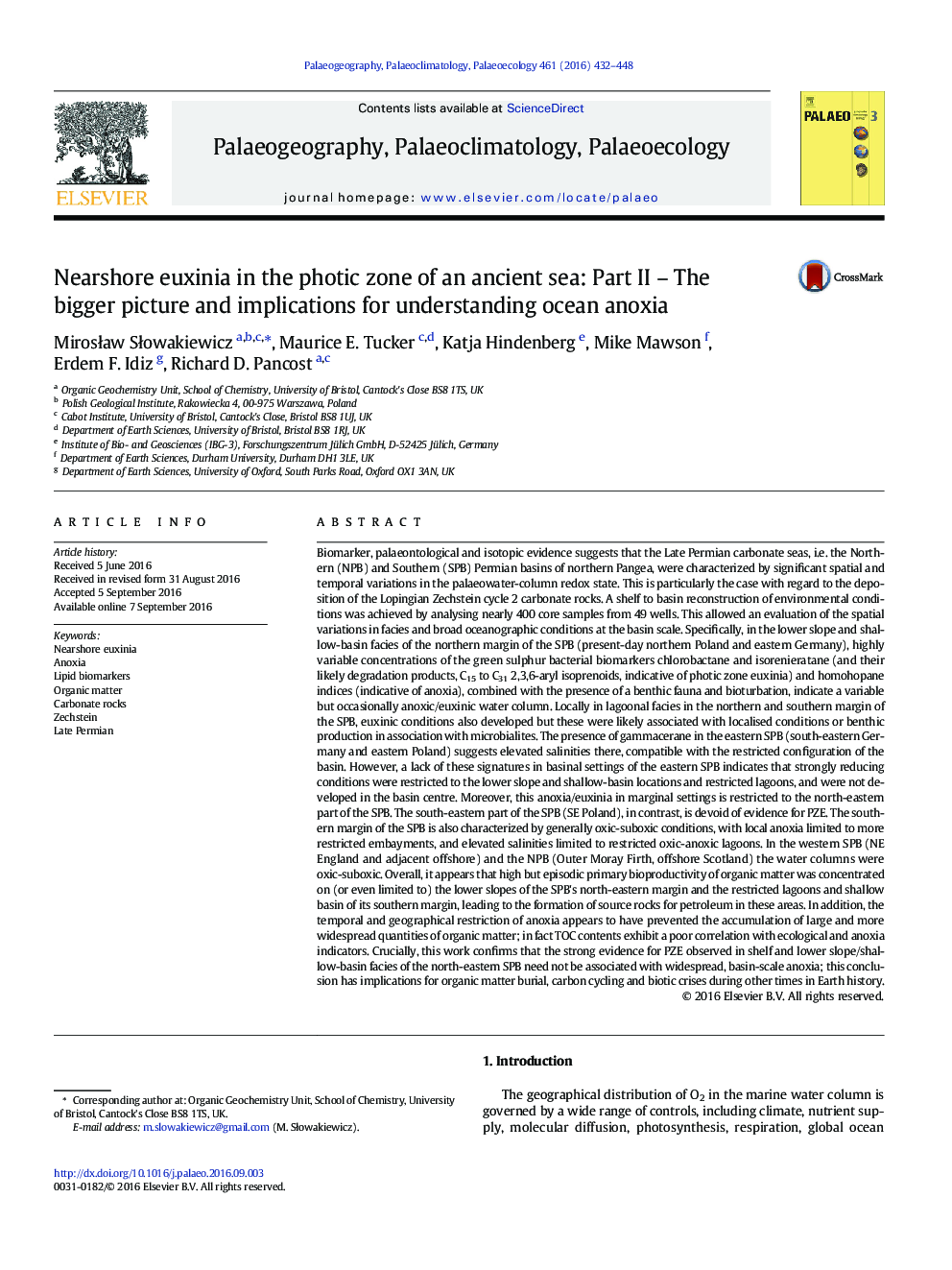| کد مقاله | کد نشریه | سال انتشار | مقاله انگلیسی | نسخه تمام متن |
|---|---|---|---|---|
| 4465549 | 1622130 | 2016 | 17 صفحه PDF | دانلود رایگان |
• A shelf to basin reconstruction of redox conditions.
• Spatial variations in facies and oceanographic conditions.
• Euxinia in marginal locations is not associated with widespread basin-scale anoxia.
• A model of spatially heterogeneous anoxia is presented.
• Implications for understanding ocean anoxia at other times.
Biomarker, palaeontological and isotopic evidence suggests that the Late Permian carbonate seas, i.e. the Northern (NPB) and Southern (SPB) Permian basins of northern Pangea, were characterized by significant spatial and temporal variations in the palaeowater-column redox state. This is particularly the case with regard to the deposition of the Lopingian Zechstein cycle 2 carbonate rocks. A shelf to basin reconstruction of environmental conditions was achieved by analysing nearly 400 core samples from 49 wells. This allowed an evaluation of the spatial variations in facies and broad oceanographic conditions at the basin scale. Specifically, in the lower slope and shallow-basin facies of the northern margin of the SPB (present-day northern Poland and eastern Germany), highly variable concentrations of the green sulphur bacterial biomarkers chlorobactane and isorenieratane (and their likely degradation products, C15 to C31 2,3,6-aryl isoprenoids, indicative of photic zone euxinia) and homohopane indices (indicative of anoxia), combined with the presence of a benthic fauna and bioturbation, indicate a variable but occasionally anoxic/euxinic water column. Locally in lagoonal facies in the northern and southern margin of the SPB, euxinic conditions also developed but these were likely associated with localised conditions or benthic production in association with microbialites. The presence of gammacerane in the eastern SPB (south-eastern Germany and eastern Poland) suggests elevated salinities there, compatible with the restricted configuration of the basin. However, a lack of these signatures in basinal settings of the eastern SPB indicates that strongly reducing conditions were restricted to the lower slope and shallow-basin locations and restricted lagoons, and were not developed in the basin centre. Moreover, this anoxia/euxinia in marginal settings is restricted to the north-eastern part of the SPB. The south-eastern part of the SPB (SE Poland), in contrast, is devoid of evidence for PZE. The southern margin of the SPB is also characterized by generally oxic-suboxic conditions, with local anoxia limited to more restricted embayments, and elevated salinities limited to restricted oxic-anoxic lagoons. In the western SPB (NE England and adjacent offshore) and the NPB (Outer Moray Firth, offshore Scotland) the water columns were oxic-suboxic. Overall, it appears that high but episodic primary bioproductivity of organic matter was concentrated on (or even limited to) the lower slopes of the SPB's north-eastern margin and the restricted lagoons and shallow basin of its southern margin, leading to the formation of source rocks for petroleum in these areas. In addition, the temporal and geographical restriction of anoxia appears to have prevented the accumulation of large and more widespread quantities of organic matter; in fact TOC contents exhibit a poor correlation with ecological and anoxia indicators. Crucially, this work confirms that the strong evidence for PZE observed in shelf and lower slope/shallow-basin facies of the north-eastern SPB need not be associated with widespread, basin-scale anoxia; this conclusion has implications for organic matter burial, carbon cycling and biotic crises during other times in Earth history.
Figure optionsDownload high-quality image (198 K)Download as PowerPoint slide
Journal: Palaeogeography, Palaeoclimatology, Palaeoecology - Volume 461, 1 November 2016, Pages 432–448
